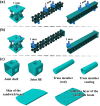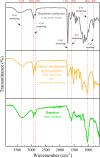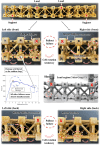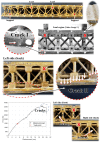Fully bio-based composite and modular metastructures
- PMID: 40612640
- PMCID: PMC12213883
- DOI: 10.1007/s42114-025-01359-1
Fully bio-based composite and modular metastructures
Abstract
The reliance on fossil-derived components in the design of metamaterials and metastructures presents sustainability and environmental challenges, prompting the development of alternative solutions. In response, this study proposes a fully bio-based and modular metastructure composed of rods extracted from the giant bamboo (Dendrocalamus asper) and plant-based polymeric joints derived from soybean (Glycine max) and castor oil (Ricinus communis), aiming to offer a sustainable alternative for load-bearing structural components. The research investigates the design, fabrication, and mechanical performance of a unit trussed cell (50 × 50 × 50 mm3) engineered to exhibit auxetic-like chiral rotation and enhanced energy absorption under compressive loading. These cells are assembled into trussed beams (400 × 50 × 50 mm3), and further into sandwich beams with 5 mm thick balsa wood skins. Material properties of the bamboo and polymer components are assessed via physical, chemical, and mechanical characterisation to asses their potential chemical-adhesion compatibility, density, and mechanical performance. Following the fabrication of the proposed structures, further experimental evaluation includes compression of the trussed cell and four-point bending of the beam configurations, while finite element analysis (FEA) is used to simulate elastic behaviour under torsional and cantilever loading. Results demonstrate that the metastructure trussed cell (with a mass of ~ 30 g) supports up to 700 kg in compression, achieving ~ 2 mm displacement, 4° rotation, and absorbing ~ 750 μJ/mm3 of energy; it also exhibits a force-displacement slope of ~ 4,200 N/mm and an equivalent Poisson ratio near zero within the elastic regime (up to ~ 1 mm displacement). The trussed and sandwich beams exhibit equivalent densities of ~ 0.19 and ~ 0.21 g/cm3, respectively, while achieving bending loads of ~ 2000 N and ~ 3600 N, corresponding to maximum bending moments of ~ 103 and ~ 188 kN∙mm, and toughness values of ~ 158 and ~ 193 μJ/mm3, respectively. Simulated torsional response of the trussed cell indicates a torque of ~ 7,300 N∙mm per degree of twist, while FEA results for cantilever loading show a homogenised flexural modulus of the beams of ~ 623 MPa (trussed) and ~ 751 MPa (sandwich). These outcomes underscore a promising direction for developing renewable, high-strength, and lightweight composite structures, with applications ranging from civil construction to aerospace engineering.
Keywords: Bamboo; Beam; Bio-based polymers; Composite structure; Lattice; Metastructure; Sandwich structure; Truss.
© The Author(s) 2025.
Conflict of interest statement
Competing interestThe authors declare no competing interests.
Figures
























References
-
- Sarvestani HY et al (2018) 3D printed meta-sandwich structures: failure mechanism, energy absorption and multi-hit capability. Mater Des 160:179–193. 10.1016/j.matdes.2018.08.061
-
- Yan S et al (2024) Bio-inspired mechanical metamaterial with ultrahigh load-bearing capacity for energy dissipation. Mater Today 77:11–18. 10.1016/j.mattod.2024.06.003
-
- Kong W et al (2023) Flexural performance of steel fiber reinforced concrete filled stainless steel tubular trusses. Compos Struct 303:116266. 10.1016/j.compstruct.2022.116266
-
- Hunt CJ et al (2019) WrapToR composite truss structures: improved process and structural efficiency. Compos Struct 230:111467. 10.1016/j.compstruct.2019.111467
LinkOut - more resources
Full Text Sources
